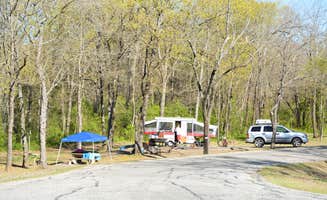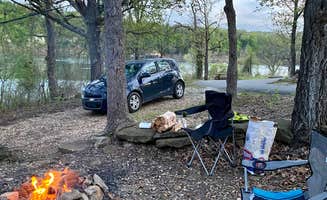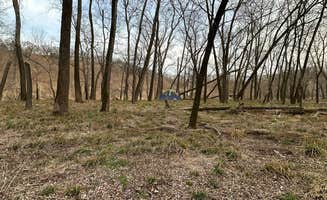Tent campers exploring the area around Muldrow, Oklahoma find a variety of primitive and developed camping options within the eastern Oklahoma region. Located in the foothills of the Ozark Mountains at an elevation of around 500 feet, this area experiences hot, humid summers and mild winters, with spring bringing substantial rainfall that affects camping conditions. Many tent sites in the region feature natural elements like riverside locations, rocky terrain, and forested settings that require preparation for changing weather patterns.
What to do
Fishing opportunities: At John Paul Hammerschmidt Lake Springhill Campground, campers can access bank fishing along Arkansas River outlets. One visitor noted, "Great area with many spots that back up to an outlet of the Arkansas River. Great bank fishing!"
Mountain biking trails: The trails around Springhill Campground offer challenging terrain for bikers. A reviewer mentioned, "Mountain biking is a big deal here and there is a 10-mile 'fast' trail where experienced bikers race frequently."
Kayaking on Illinois River: The calm sections near Horseshoe Bend Primitive Public Use Area provide excellent paddling. A camper described, "Kayakers put in and paddle upstream and float back to boat landing. There is a small parking area for boats and trailers."
Wildlife watching: The riverside camping areas serve as bird watching hotspots. One visitor to Horseshoe Bend shared, "It is a bird watcher's paradise, and we saw a lot of people fishing. I was able to see multiple species of Oklahoma's woodpeckers, some birds of prey, and many songbirds."
What campers like
Natural water features: At Natural Dam, the waterfall creates a peaceful atmosphere. A visitor wrote, "It was chilly in the morning, so the fog off the waterfall was eerily gorgeous."
Wooded tent sites: Gates Nature Preserve offers secluded spots near water. A camper described, "Our little campsite was so cozy with a table, a fire pit and a grill. It was right next to the creek!"
Quiet evenings: Several camping areas provide calm nights with natural sounds. A Natural Dam visitor noted, "Quiet evening without disturbance. Several cars there but no other campers."
Convenient locations: Many sites offer proximity to towns while maintaining a natural setting. A John Paul Hammerschmidt camper mentioned, "The location was great to downtown Fort Smith so you didn't feel isolated if you wanted to go sight-seeing, out to eat, or shopping."
What you should know
Access road conditions: Some primitive camping areas have challenging roads. At Horseshoe Bend, a camper warned, "Warning it is a dirt track and it is severely rutted and potholed. If it has rained prior or while you are camping the road will be a total mess."
Changing regulations: Check before planning overnight stays. A recent Horseshoe Bend visitor noted, "We did camp there in a tent for one night, but were politely told by a game warden the next day that, though it used to be open for that, it is no longer allowed."
Reservation systems: Some campgrounds require advance booking. At Springhill, a camper advised, "You need to make a reservation on recreation.gov in order to pay for a spot. We didn't know this in advance but were able to find a spot, log in and pay."
Leveling challenges: At Hickory Flats — Tenkiller State Park, tent sites may require careful setup. One visitor to the area mentioned, "Only about half the sites were flat enough for us to get level without having the wheels off the ground."
Tips for camping with families
Check noise factors: Some campgrounds have ambient sounds that affect sleep. A Natural Dam visitor mentioned, "A little road noise off in the distance but the waterfall all but drowned it out."
Look for educational opportunities: Elephant Rock Nature Park offers learning experiences. A visitor shared, "Kid friendly area. There's really a rock that looks like an elephant, too!"
Plan for weather variability: Spring camping requires extra preparation for rain. A camper noted about the area's terrain, "If it has rained prior or while you are camping the road will be a total mess and campers will have a difficult time getting in or out."
Pack exploration gear: Many sites offer natural features worth investigating. A Gates Nature Preserve camper shared, "Jill was so welcoming and warm, and she even showed us around some of the beautiful trails (which are definitely 'hidden' gems)."
Tips from RVers
Site length considerations: At John Paul Hammerschmidt campground, large vehicles need specific sites. A reviewer noted, "Many sites are very long with only eleven sites being less than 45' in length (and only seven under 40')."
Leveling requirements: RV sites at many area campgrounds need attention to leveling. One camper observed, "Smaller RVs or trailers that use blocks instead of automatic leveling jacks should be able to get level."
Loop selection matters: Different camping loops offer varied experiences. At Eagles Point — Tenkiller State Park, a visitor explained, "The park is LARGE. The plus to that is despite busy holiday weekends, spring flooding or special event weekends, you can always find a place to pitch a tent."
Utility access varies: Water hookups may not be obvious when booking. A camper at Springhill shared, "When looking at the 'site list' page you will notice no sites have water listed as an 'amenity' but it does list the electric. To find out if a site has water, click on the link for specific details."




